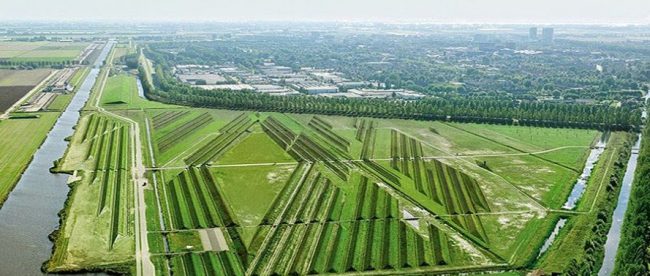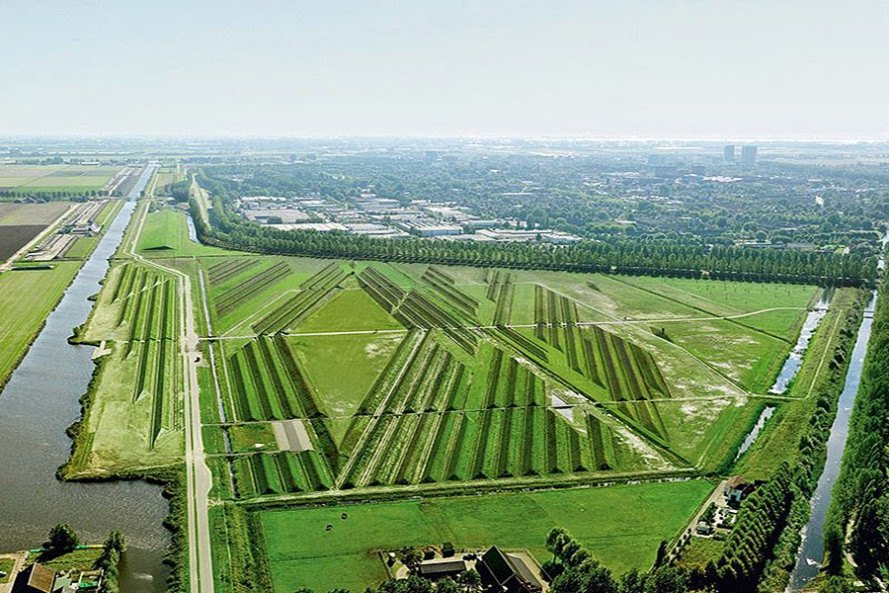The Art of No Noises


If you’re flying into Amsterdam, there’s a pretty good chance you’ll be able to see the above for yourself. Right next to Schiphol Airport is something called Buitenschot Land Art Park, the formal name for the public space pictured. Like most parks, it’s open to the public. If you’re in the area, you can take advantage of its ballfields, bike paths, and bespoke art installations which dot the 80-acre expanse. Or you can just grab a seat on one of the park’s many benches and watch the planes fly overhead. You’ll have plenty of opportunities — Schiphol serves over 1,500 flights on a typical day.
But recreation isn’t why Buitenschot Land Art Park exists. All of those planes are. Or, more accurately, the park is there because of the noise those planes make.
If you’re thinking about building an airport, it makes a lot of sense to put it somewhere with flat terrain, if for no other reason than there is less stuff for planes to crash into. That was probably one of the reasons Schiphol Airport is where it is — it occupies the space formerly inhabited by a lake (which has since been dredged out) and its accompanying lowlands. That comes at a cost, though: Planes make a lot of noise, and flat terrain means that there is nowhere for that noise to go. Per Travel and Leisure, there were some reports “that locals could hear the low drone of arriving and departing planes from 18 miles away” which, to say the least, is kind of bonkers.
Unfortunately, that’s not a problem easily fixed. If we were dealing with cars, you’d just put up the traditional roadside soundproofing, but for air traffic, that doesn’t fix the problem. As Atlas Obscura explains, “the tricky thing about dampening airport noise is that the noise is a very low frequency with a very long wavelength, around 36 feet, so a simple barricade will do little to stop the drone.” You’ll need to get creative.
So that’s what the Amsterdam authorities did. It turned out that the noise levels ebbed in the fall, and after some investigation, the researchers looking into the matter found out why: farmers near the airport were plowing their fields. The plowed land seemed to dampen the sound. The science made sense — per Smithsonian, the farmland “had multiple ridges to absorb the sound waves,” and they “deflected the sound and muted the noise.” Replicating (and optimizing) the design seemed like a good way to lessen the airplane noises permanently.
A design firm, H+N+S Landscape Architects, and an artist named Paul De Kort got to work, creating the park seen above. The ridges disperse the sound — here’s a diagram put together by H+N+S — while the open spaces act as a place for locals to relax and play. And yes, the sound dampening efforts worked; according to Smithsonian, “Buitenschot cut the decibel level of the ambient noise in half almost immediately” after it opened in 2013.
Bonus fact: Olympic Stadium in Amsterdam was the main site of the 1928 Summer Olympics, and it holds a unique place in history — it’s the only building to earn a gold medal during the Games it hosted. How does a building earn an Olympic medal? Art competitions were part of the Summer Games from 1912 to 1948 — Smithsonian has an in-depth history — and one of the art categories for the 1928 Games was “architecture.” The gold medal that year went to Jan Wils, a Dutchman, for his work designing the stadium which housed the Games.
From the Archives: A Fly on the Urinal: Another one of Schiphol Airport’s great innovations.
